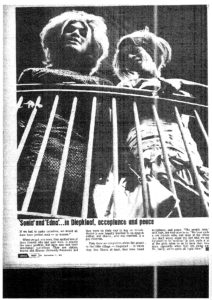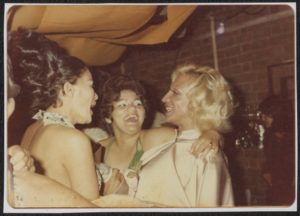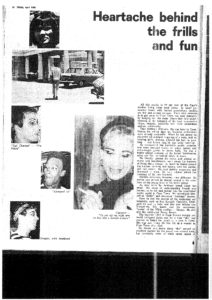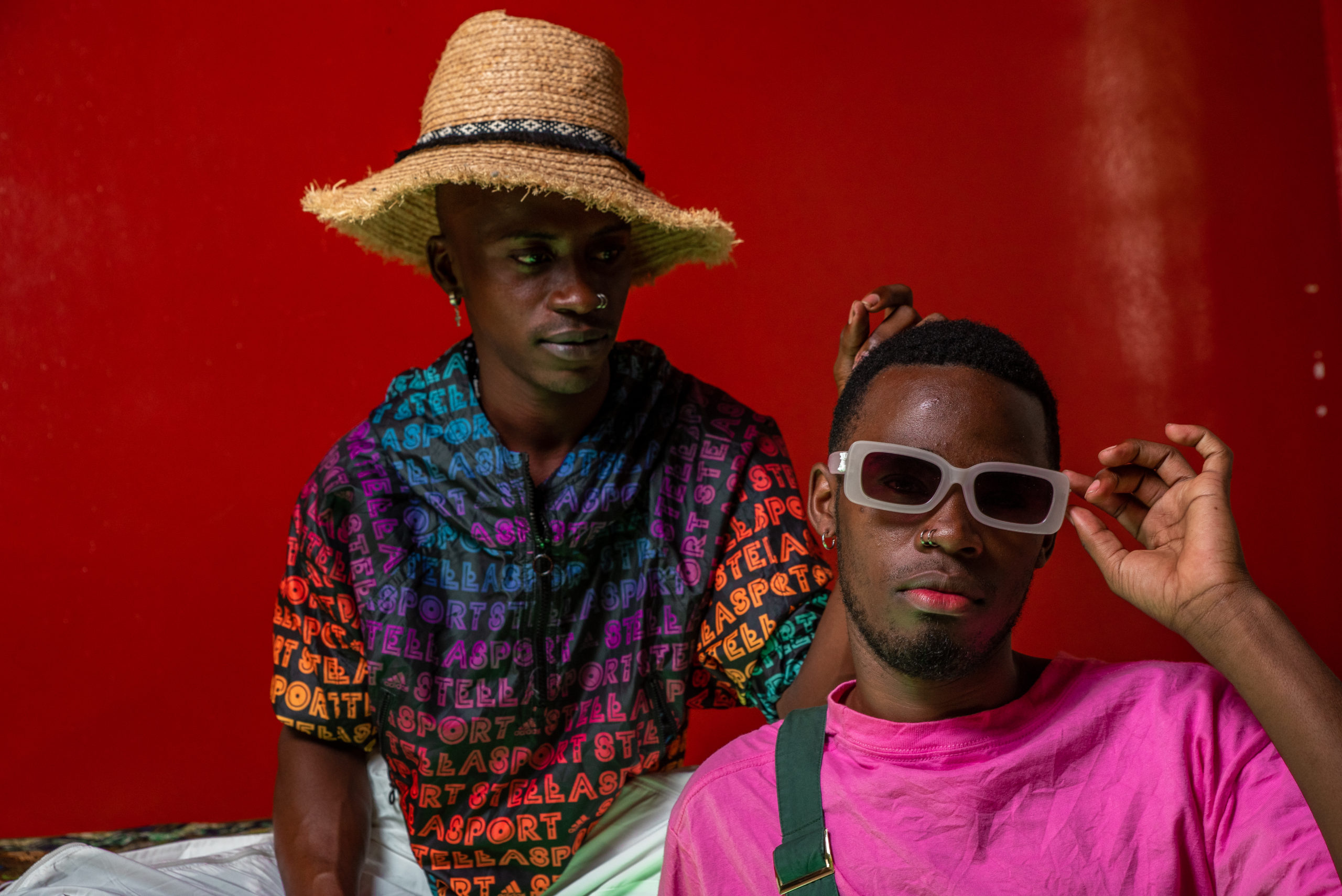
“‘If we had to make ourselves, we would all have been perfect men – or women.’ When we got into town, they spotted two of their friends who had been in exactly the same position but now have had their sex change operations. They are sisters Muriel and Sharon (formerly, Peterson) and were on their way to buy air tickets.”- Drum Post, September 1965
Without digging into the archives, it’s easy to believe that this era is the first time in history that LGBTQIA+ visibility in South Africa is making headlines. Growing up without elders and icons that represented me, I latched onto any semblance of diversity that I found in the Western media.
As activists, archivists and researchers work to reframe history, audiences like ourselves are astounded to discover the generations of gender diverse South Africans, who were always a trending topic in the media. From pre-colonial records to Apartheid and Post-Apartheid South Africa, the media’s lens on queerness and transness is everchanging. What is a constant is the existence and resilience of people of diverse gender and sexual identities.
Age-old biases that claim LGBTQIA+ experiences are ‘un-African,’ Western innovations are far past their expiration date. Earlier this year, Minority Africa’s Cassandra Roxburgh exposed the colonial influences of the constructs of transphobia and homophobia, which continue to prevail in contemporary society.
While these biases have been long-standing in South African culture, the existence of gender diverse people in historical media also points out a societal tolerance and interest.
LGBTQIA+ South Africans have been here before colonization.
South African archival evidence of same-sex relationships from pre-colonial times is hard to find, partly due to the way data is categorized or uncategorized. On a quest for evidence of gender and sexuality diversity in pre-colonial times, author of Hungochani: The History of a Dissident Sexuality in Southern Africa, Marc Epprecht hunted between an array of records on Shona culture.
In a 2013 seminar for the Human Sciences Research Council (HSRC), Epprecht describes the treasure he discovered in his research: “I stumbled upon a hidden gem – documented proof of the first known use of the word nkotshane more than 100 years ago (from which today’s word for homosexuality in chiShona derives), and transcripts of trials where African men speak to us from generations past to tell of their love for each other.”
Across the African continent and throughout history, gender and sexual diversity have existed without being labelled under the same constrictive language that we employ today. While it’s encouraging to think of the endless pool of evidence in the archives that confirm the rich LGBTQIA+ history in South Africa, it often poses a challenge to researchers like Epprecht, since little of the evidence is categorized or indexed.
Before the establishment of criminal labour systems, same-sex relationships were not criminalized in South Africa. As colonial rule was established, laws developed, becoming increasingly prejudiced towards queer people.
As Apartheid laws progressed, the atmosphere of homoantagonism became more rampant. In 1966, the South African police force raided a gay party in Forest Town, Johannesburg, serving as the impetus to create the first explicitly anti-homosexual legislation.
Author of the acclaimed book Defiant Desire: Gay and Lesbian Lives in South Africa, Mark Gevisser’s work reveals another event that year that contributed to the increasingly queer antagonistic policy changes. In the book, he explains, “On a weekend in January 1966, police arrested nine men for masquerading as women and participating in ‘indecent activity.’ The raids and arrests at this time had gained public and media attention, further contributing to colonial-enforced gender and sexuality biases.’
Three years after the Forest Town Raid, the Immorality Amendment Act, 1969 was put in place. Featuring an explicitly anti-homosexual agenda, Section 20A, commonly known as the ‘men at a party clause’ remained in place until 1998, at which point, the Act was ruled unconstitutional.
While the LGBTQIA+ community in South Africa has always included a spectrum of diverse identities, the framing of the Act was centered on cisheteropatriarchal biases that further enforced rigid gender identities. In reality, all the ‘men at the party’ could have included a spectrum of non-male attendees, including non-binary people and women who were misgendered as male.
Further, Section 20A of the Immorality Amendment Act outlined prohibitions for ‘males’ only, highlighting the erasure of gender and sexual diversity in legislative framing.
Even in the heat of the apartheid, LGBTQIA+ people made headlines.
During the 1940s, District 6 (or District Six) in Cape Town was a flourishing hub of culture that housed diverse people from across the Asian and African diasporas. The close-knit community was normalized to gender non-conformity and sexual diversity, with residents living beside LGBTQIA+ in the neighbourhood. Queer couples lived in partnership and were recognized as respected members of the community.
The Gay and Lesbian Memory in Action (GALA) Queer Archive has extensively demonstrated the gender and sexuality diversity in District 6 through exhibitions and educational programmes that bring the archives to life. The 2018 public unveiling of their archives exposed the social visibility of gender non-conforming people in both the media and public gaze. Their ongoing acclaimed exhibition, Kewpie: Daughter of District 6 features a collection of images that document the life of a gender non-conforming hairdresser in the 1950s, stirring up media attention and stealing the hearts of contemporary audiences across the world.

The images illustrate the illustrious and vibrant experiences of diversity in District 6. To see LGBTQIA+ people living in their truth in the 1950s was surprising to witness in black and white. It served as evidence that we have always been here, despite the common notions that this generation is the first to live so freely.
Stumbling across the Kewpie exhibition was the catalyst that retriggered my obsession with archival research. As a queer, trans non-binary journalist and artist, I was touched to connect with a generation of elders, expressing queer joy and resilience amidst the violence of the Apartheid state. I quickly noticed how language has changed significantly over the decades since I had become normalized to western language and contemporary gender discourse. While non-binary people certainly existed in District Six, there was no fixed term to describe them. Language ranged from nicknames to derogatory terms such as ‘moffie.’ Even the derogatory terms were reclaimed by the community themselves, launching them into headlines and iconicism.
The Drum decade paid homage to queer South Africans.
It’s difficult to weigh the cultural and political impact of The Drum Magazine in South African history. At the height of apartheid, the first issue of The African Drum was published in 1951, building an international legacy for African journalism and birthing the careers of literary heroes such as Nat Nakasa.
As I flipped through The Drum archives at The National Research Library in Cape Town, I was astounded to see how the publication was used to connect South Africans to the Afro Diasporas in the USA, UK and Europe. With an established international readership and a network of pen pals abroad, the publication both educated readers and helped them establish political coalition and allyship.
While many contemporary readers may not realize the cultural significance of a Drum feature in the 1960s, it was such a cultural centerpiece to the Afrodiasporas that Muhammad Ali wrote for The Drum on three occasions. The Drum was the pinnacle of media coverage during its era, and without fail, LGBTQIA+ people were making headlines too.
My jaw dropped when I saw Kewpie in The Drum Magazine. I nudged my colleague, “She really was famous. Kewpie’s legacy expanded beyond District Six.” I wondered if Muhammad Ali saw Kewpie in The Drum Magazine and whether she was networking with pen pals abroad.

A Drum article titled ‘Heartache behind the frills and fun’ was published in April 1968. While the story offers a necessary platform to highlight the plight of trans exclusion within communities, the language and framing can be seen as derogatory and unsavory to contemporary audiences. The introductory excerpt of the story reads,
“All this results in 99 percent of the Cape Town moffies living away from home. In small upcountry towns with limited populations, moffies are few and attract derision. The only recourse is to get away to Cape Town and seek obscurity by emerging into the mass. There they find understanding in the company of the local transvestite clique, stepping smoothly into their established odd-sex community.”
The framing of the trans community is jarringly problematic to readers who are familiar with contemporary gender discourse. While derogatory terms may have been reclaimed by LGBTQIA+ people at the time, the framing of trans people as obscure is a microcosm of the type of media representation gender diverse people experienced in the media during this era.

Caption: This is “Joan” and “Sonia”. They are misfits in ordinary society, mocked at, maligned. They are men who feel, think, act, dress like women, and so are insulted, ridiculed. “Please,” they simply say. “We can’t help the way we feel. Blame God, who made us, if you must.”
The title and caption of this story and image employ an editorial tactic referred to as sensationalism, which seeks to excite the audience through wording and framing. It’s clear that Drum Magazine pays homage to the LGBTQIA+ community in its efforts to offer a consistent platform for underrepresented issues of marginalized people, including transantagonism.
However, without exposure to the necessary gender diversity reporting tools or established industry standards around reporting on marginalized people, journalists throughout the ages often reiterate violence against the same community they are trying to represent. By labeling them as misfits and misgendering them in the framing, the article creates a spectacle of their transness rather than framing the focus on the obscurity of transphobia.
Even more astoundingly, this type of representation did not die out in the 1960s, as contemporary journalists continue to deadname, misgender and cause trans erasure to their sources in the hopes of visibility. With the modern addition of social media, newfound vectors of misrepresentation of queer/trans people are found online. While many might argue that the issues of misgendering, transantagonism and dysphoria affect queer/trans people as a minority population, these systems have a chokehold on everyone including cisgender people.
Platforms like Twitter have been used to reinforce binarist antagonism, creating guidelines of what a ‘real’ woman looks like. Just last month, a heated gender-related attack arose and trended on South African Twitter, surrounding an up-and-coming Amapiano DJ who has been making waves across the world. A cisgender woman and ally to the LGBTQIA+ community, Uncle Waffles spoke out about the antagonism she received about her body type. Antagonistic Twitter users questioned her gender assignment and made remarks about her physique. She responded in a tweet, “You can’t always have something to say. I’m a proud ally of the trans community, always have been. Yall, without fail will always have something to say.”
The framing of gender in this twitter debate highlights how contemporary South African media is still hypercritical of gender across the spectrum, prescribing norms that lean towards cisheteropatriarchy. Using transness or gender non-conformity as a vehicle for antagonistic jokes and insults is a common way cisgender people experience glimpses of the system of cisheterosexuality failing them. Other common embodied examples include the experience of cisgender women who fear looking masculine by not shaving their legs, having biceps, etc. Over time, lenses in the media have been used to reinforce what a proper cisgender person must do to uphold their manhood or womanhood, placing an enormous amount of pressure to not appear trans and face public scrutiny.
Despite the ripple effects of these antagonisms on all identities under the spectrum and the constitutional pledges towards equality, South African media outlets still promote narratives that belittle the weight of erasure. In January this year, The Mail and Guardian published an Op-ed that sparked a wave of social responses. Titled ‘A weird new sort of fascism,’ the article criticizes the normalization of trans-inclusion, problematizing people who speak up for trans rights.
In a response piece, Zama Ndlovu explained the experience of engaging with this media for readers,
“When I saw Drew Forrest’s piece that argued that fighting against trans-exclusionary views is a type of fascism, I was appalled that this piece would run in my beloved M&G. By publishing a piece that equated the protection of human rights to fascism, this publication failed the trans community, its readers and our hard-fought Bill of Rights.”
While these historical archives may be more blatantly problematic to readers, contemporary journalists may be well versed with dialect and misuse terminology. A common example is when journalists introduce a non-binary person’s pronouns as “She uses they/them pronouns.” It’s easy to criticize a previous generation’s reporting on marginalized people because we are at a distance, however, it’s important to acknowledge that representation is relative and there is a lot of work to do in our own media depictions.
The gender revolution is not new.
Before the end of apartheid, the first pride parade was held on October 13 1990 in Johannesburg. Four years later, apartheid ended and a new constitution was formed. Since ‘the birth of the new South Africa,’ people across marginalized groups have raised questions about the legitimacy of the rainbow nation and an equal South Africa.
While laws created more allowance for LGBTQIA+ people to live freely, the legislation does not always lead to automatic changes in community stigmas. South African artists like Zanele Muholi have been building bodies of works for over a decade, establishing new modalities for queer South African representation on a global scale. While queer artists like Muholi have received accolades across the globe and are iconized in the West, South Africa still frequently ignores and oppresses gender minorities daily.
One example that gained media attention is the uproar over Jade September, who won her case to be transferred to a women’s prison. While at a glance the South African constitution advocates for equality for all people, many gaps excluding and marginalizing citizens like September. In her case, the legislative erasure led to her receiving violence and human rights violations, as she was forced to be in a male prison. In September 2019, the Equality Court of The Western Cape handed down a judgment that would impact the lives of trans-South Africans.
Lawyers For Human Rights reports, “In a ground-breaking judgment, the Court held that refusal to allow a transgender person to express their gender identity is unfair discrimination that violates both the right to equality and section 8 of the Promotion of Equality and Prevention of Unfair Discrimination Act. The Court therefore ordered prison officials to allow Ms. September and others similarly placed to wear female underwear, keep her hair long and wear make-up. It also ordered officials to address her as a woman through the use of the female pronouns when referring to her. The Department of Correctional Services was also ordered to introduce transgender sensitivity training for current and new employees.”
This ruling highlights constitutional and legislative gaps that incite violence against trans and queer South African, and simultaneously points out the labour that is required from oppressed and marginalized groups to maintain their basic human rights. Undoubtedly, September was not the first woman that was wrongly placed in the male prison system. Her case shines a light on the innumerable and underreported number of people who quietly face antagonism under the blanket of erasure.
In 2017, The National Geographic Magazine released a special issue titled The Gender Revolution, highlighting trans and non-binary identities. The issue of this international publication circulated in South Africa as social media users reposted the covers and new-found rhetoric. Looking at the scale of gender diversity throughout history, it’s fair to say that framing a gender revolution as a 2017 concept employs a level of sensationalism. With a longstanding history of gender diversity in media, it is evident that gender is as ever-adapting as the lenses we frame it through. What’s evident is that queer and trans people have been making the headlines for a long time.
Whether erased, celebrated or sensationalized in the media, South Africans have been familiar with gender non conforming community members for all of history. From family members to neighbors and the icons we’ve come to know in each era, LGBTQIA+ people living in their truth have had a radical intergenerational effect on creating room for future generations to live with more freedom.

“Recently, three of them caused a sensation when they appeared in court, dressed in women’s clothes on charges of masquerading as women.” – Drum Post, September 1965.
This reporting was supported by the International Women’s Media Foundation’s Gender Justice Reporting Initiative.
Edited by Cassandra Roxburgh, PK Cross, Caleb Okereke, and Uzoma Ihejirika.


